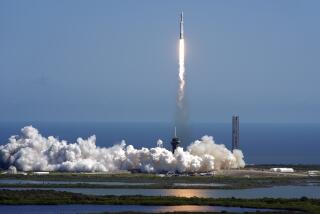Mapping out the search for life on Jupiterâs watery moon Europa
Is there life on Jupiterâs icy moon Europa? Scientists would like to find out.
âIt does have the right ingredients,â said Robert Pappalardo, a scientist at the Jet Propulsion Laboratory and lead author of a new study outlining what might be learned from a spacecraft that landed on the mysterious moon.
âIt likely has water, and the right chemistry to support life, and the potential chemical fuel that could make life possible,â he said.
Europa is about the size of the Earthâs moon and covered in a thick sheet of ice estimated to be about 15 miles deep. But beneath that icy shell, scientists believe Europa contains a liquid, salty, global ocean that could be conducive to life.
PHOTOS: Moons of the solar system
Europa was discovered in 1610 by Galileo. Voyager I and II both flew past the moon in 1979 and found intriguing hints that its cracked icy surface could conceal a vast ocean.
More evidence of Europaâs hidden ocean was found by the Galileo spacecraft in 1996, when its magnetometer noticed the entire moon was acting as a conductor - indicating it has a salty ocean inside.
But to determine whether there is life in that ocean, scientists would like to send a spacecraft that can land directly on Europaâs icy surface.
Sending a lander to Europa is not officially part of NASAâs plans, but the agency asked Pappalardo and a far-flung team of planetary scientists to lay out what they would hope to learn if and when a spacecraft landed on the tantalizing moon.
In a study published in the journal Astrobiology, the team said it was mostly interested in Europaâs chemical composition - learning what makes up the rust-colored freckles and cracks that stain its surface, and if there are any organic materials that could serve as the building blocks of life as we know it.
âFrom a fly-by mission we could get a better understanding of what this dark red stuff actually is, but from the surface, we could scoop up some of that stuff and do sophisticated analyses onboard the lander,â Pappalardo said.
The scientists would also like to learn more about Europaâs ocean, and study the moonâs surface geology.
Pappalardo said NASA was probably years away from sending a lander to Europa, or even launching a mission to fly by it.
âIn the outer-planet community you have to think decades ahead,â he said. âBut it is very exciting to think about and lay the foundations for the possible science objectives that we would go after.â







